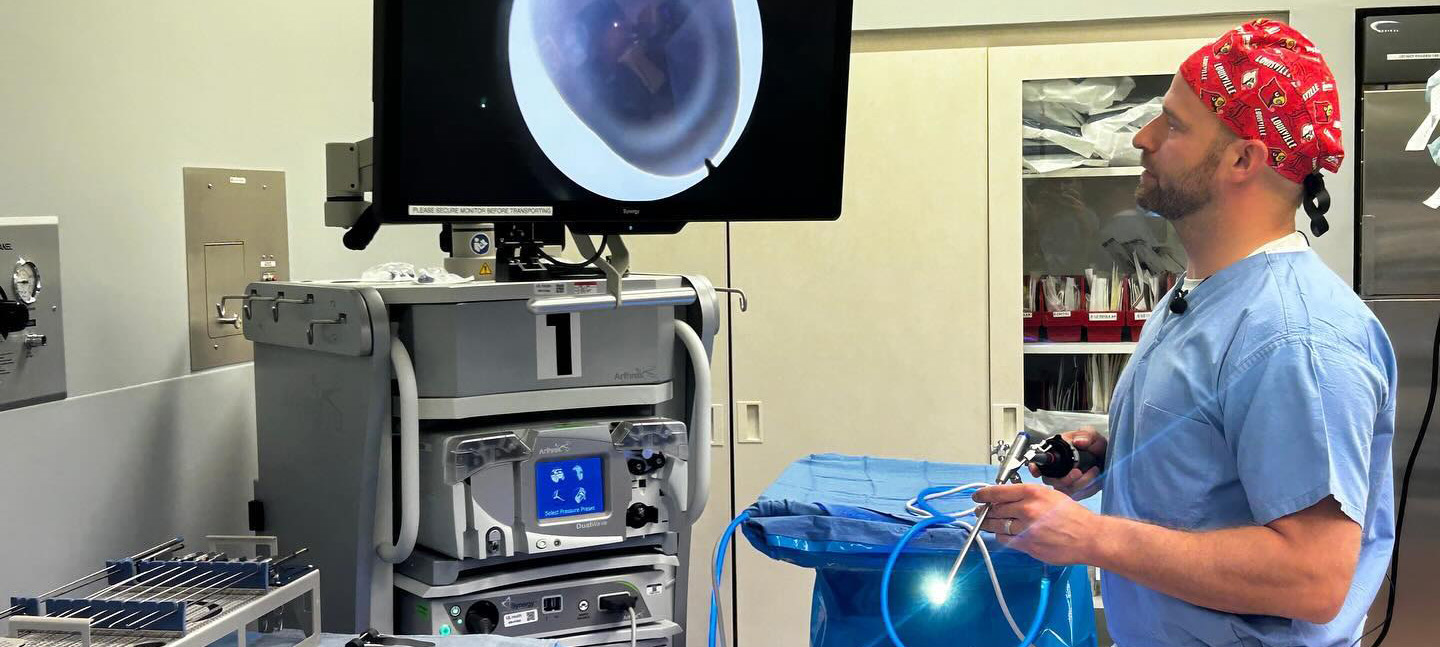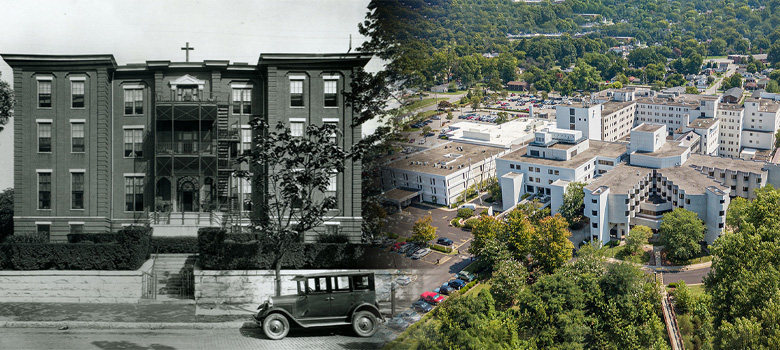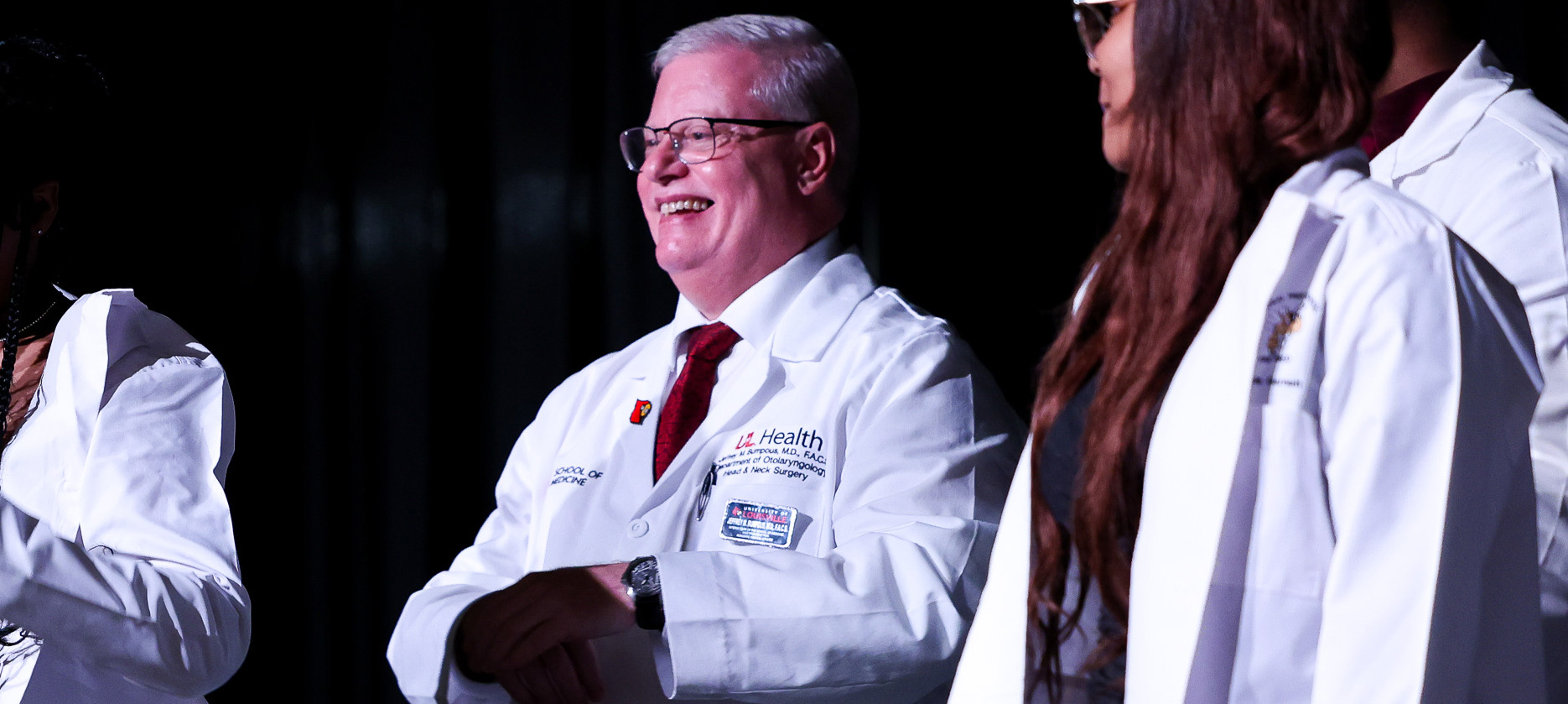Total Joint Replacement Surgery
Is an injury or pain in your joints causing you to not fully experience life? At UofL Health, minimally invasive joint replacement procedures are being used every day to help patients begin moving again. Our comprehensive joint replacement program is personalized to the needs of each patient, and includes evaluation, non-operative options, and extensive education.
Our orthopedic physicians are leaders in the field and train other doctors in advanced surgical methods. Their goal is to improve a patient’s quality of life by providing state-of-the-art techniques and implants, and a comfortable hospital experience.
Before scheduling a surgical procedure, patients are evaluated for treatment with non-steroidal medications, physical therapy, and visco-supplementation. If surgery is necessary, physicians determine the least invasive options for the best outcome.
Minimally invasive methods such as total knee replacements and hip replacements involve the use of smaller incisions than those used in traditional surgeries. Because there is less damage to the tissue, patients who undergo these procedures may expect a shorter hospital stay, a shorter recovery and a better-looking scar.
All minimally invasive joint surgeries performed at UofL Health are centered on a technique known as muscle-sparing. No muscles are cut during muscle-sparing – they are merely separated or avoided. Because the incision is smaller and no muscle needs to be repaired, recovery is faster and less painful with these cutting-edge techniques.
State-of-the-art implants such as titanium, chrome-cobalt, ceramics, and cross-link polyethylene parts are used in every procedure. Each patient receives individualized care based on their needs with respect to the approach and implants used. The joint replacement team includes anesthesiologists that specialize in post-operative pain management skills to provide a more comfortable experience during the hospital stay.
Physical therapists see patients during their hospital stay for gait training and functions of daily living. Most patients are typically discharged in two to three days after surgery once basic therapy goals are achieved.
UofL Health – Jewish Hospital Comprehensive Joint Program
Once a patient is scheduled for a total joint replacement, an appointment will be scheduled for Pre-Admission Testing one to two weeks prior to surgery. At this appointment, you will receive education on your total joint replacement.
The patient and their family meet with the orthopedic coordinator who completes the necessary pre-operative paperwork and registers the patient for surgery. The coordinator also explains how the surgery is performed, what happens after surgery, and the steps for going home. Initial discharge planning is started prior to surgery and various options are discussed concerning rehab, home health or outpatient physical therapy.
The necessary pre-operative lab work and electrocardiogram (EKG) are completed, followed by a meeting with a physical therapy professional. All of this is performed in one convenient area and is usually completed in less than two hours. The orthopedic coordinator will visit you during your hospital stay and is available to the patient and his/her families whenever necessary - whether it be during pre-operative, post-surgical or even after discharge from the hospital.
The specialists at UofL Health offer a full spectrum of innovative orthopedic and joint care to patients, including:
- Ankle, knee, hip, and shoulder arthroscopy
- Ankle replacement
- Anterior hip replacement
- Arthritis of foot, ankle, knee, hip, and shoulder
- Cartilage restoration
- Cavovarus foot deformity
- Charcot feet
- Congenital deformities
- Diabetic ulcers
- Flat feet
- Fractures and dislocations
- Foot drop
- General orthopedic medicine
- Hallux valgus
- Hand surgery
- Ligament reconstruction
- Minimally-invasive surgery
- Nerve disorders
- Orthopedic oncology
- Orthopedic trauma
- Pediatric Orthopedics
- Post-traumatic foot and ankle deformities
- PRP (Platelet-rich plasma) injections
- Resection of bone and soft tissue sarcomas
- Robotic surgery
- Special needs of athletes
- Sports Medicine (arthroscopy, ligament reconstruction and joint-preserving technology)
- Sprains and other injuries
- Tendon disorders
- Tendonitis Treatment (shoulder, elbow and knee)
- Total joint replacement, repair, and reconstruction
Mako Robotic Hip & Knee Surgeries
UofL Health offers Mako robotic-arm assisted surgeries for knee and hip replacements. These innovative procedures allow for faster recovery with less post-operative pain.
Jewish Hospital’s Total Joint Replacement Program has performed more than 1,000 Mako Robotic Assisted joint replacement procedures for patients seeking treatment with hip and knee arthritis.
During hip and knee replacements, the Mako system accurately determines the implant size and provides exact placement of the total joint replacement parts based on the individual patient’s bone anatomy. The robotic arm of the Mako system helps the surgeon performing the procedure to make precise bone cuts and place the total joint hip or knee implants to exactly match the patient’s anatomy based on the preoperative plan. The use of intraoperative computer technology and robotic-assisted surgery for total joint replacement minimizes the risk of human error in implant size, placement, and inadvertent soft tissue damage. This type of smart intraoperative technology also provides the surgeon the ability to make any necessary adjustments during the procedure in real-time to achieve the target surgical goal. Jewish Hospital, part of UofL Health, is the only facility in the region to perform these innovative procedures.
Using the Mako system’s 3D model imagery specific for that individual patient, physicians can pre-operatively plan the surgical goals on a computer screen to obtain the surgical goals to provide a pain free along with a well-balanced and stable total knee replacement and then execute the plan using the Mako robotic assisted technology in real time.
After undergoing Mako Robotic-Arm Assisted Surgery procedures, patients have reported less short-term pain than those who underwent conventional replacement surgery. Those who undergo Mako systems procedures also report faster recovery times and improved patient satisfaction.
Shoulder Replacement Surgery
UofL Health offers several shoulder replacement options for those suffering from advanced shoulder arthritis. Patient-specific procedures allow us to implant replacement components with pinpoint accuracy, and you may be able to go home the same day or next day comfortably.
Types of Shoulder Replacement
We offer anatomic and reverse shoulder replacement for those suffering from advanced shoulder arthritis.
Anatomic Shoulder Replacement
Anatomic shoulder replacement preserves the normal anatomic relationship between ball and socket, mimicking normal shoulder anatomy. The diseased humeral head or ball is removed and replaced with a new metallic substitute and the glenoid cavity or socket is resurfaced with a polyethylene or plastic.
The joint maintains its normal position and the new humeral head replacement glides over the plastic resurfacing of the socket.
Reverse Shoulder Replacement
Reverse shoulder replacement is typically reserved for patients with arthritis resulting from a large rotator cuff tear. As the name implies, reverse shoulder replacement simply reverses the orientation of the ball and socket joint—the socket is reamed into the humerus, and the ball is secured into the scapula.
Foot & Ankle Replacement
Ankle arthritic pain is just as debilitating as pain from hip arthritis. Recent developments in artificial ankle joint design have now made ankle joint replacement a viable alternative for many patients with ankle arthritis. Our highly-specialized foot and ankle orthopedic surgeons at UofL Health offer the most advanced, comprehensive foot and ankle care in the region.
Our specialists are medical doctors, trained in orthopedic surgery and then sub-specializing in surgical techniques for the foot and ankle. In addition to foot and ankle replacement, they perform a number of highly-complex procedures as well as basic foot care, including:
- Post-traumatic foot and ankle deformities
- Foot and ankle fractures
- Diabetic ulcers
- Tendon disorders
- Cavovarus foot deformity
- Congenital deformities
- Foot drop
- Toe deformities
- Charcot feet
- Flat feet
- Hallux valgus
- Foot and ankle arthritis
- Nerve disorders
- Special needs of athletes
Ankle Joint Replacement
Total ankle joint replacement procedures began in the 1970s and, due to design failures of highly constrained cemented components, subsequent results were poor, failure rates were high, and the procedure was ultimately abandoned. However, new ankle joint replacement design results in better longevity of implants because they now reproduce the shape and motion of the normal ankle joint more accurately and minimal bone resection is required to preserve bone stock.
Total ankle replacement lowers the risks of developing arthritis in adjacent foot joints over time. Compared to ankle fusion patients, patients with total ankle replacements have a better gait pattern, walk faster, and negotiate uneven terrain more easily.
Ideal candidates for total ankle replacement are patients with end-stage ankle arthritis who are older than 50, have low physical demands, are not obese, do not smoke, possess good bone stock, and have had a previous fusion of the hindfoot or midfoot. Contraindications for this procedure include infection, neuropathy, poor ankle motor control, extensive talar avascular necrosis and severe osteoporosis.
Ankle fusion is still the best procedure for young patients, obese patients and people who have high physical demands.
Following surgery, patients stay in the hospital overnight. Range of motion exercises begin approximately 10 days after surgery, and weight-bearing commences after two weeks.





